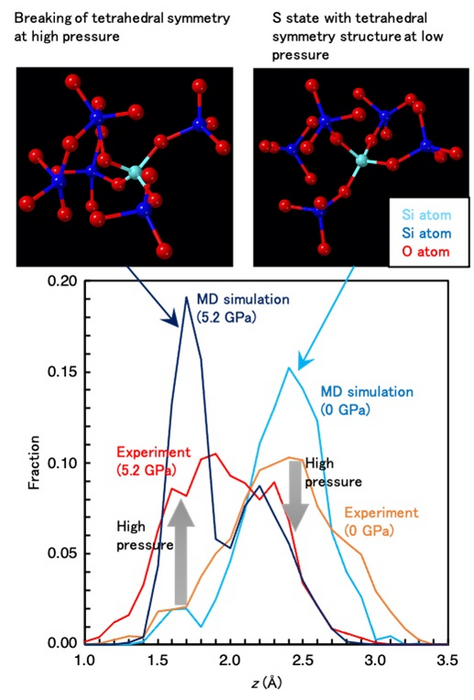Reviewed by Alex SmithJun 28 2022
Understanding the structural origin of the anomalous properties of SiO2 liquid and glass is essential in both the world of physics and geophysics, particularly when it comes to understanding the nature of silicate magmas on the Earth and other planets, and in materials science as a prototype network-forming glass.
 Translational order in SiO2 glass as a function of the parameter z obtained in our experiment with MD-RMC modeling and MD simulation with BKS model at 0 and 5.2 GPa, and the structural features of SiO2 glass with the characteristic distribution of z=2.4 Å at 0 GPa and z=1.7 Å at 5.2 GPa. Image Credit: Yoshio Kono, Ehime University
Translational order in SiO2 glass as a function of the parameter z obtained in our experiment with MD-RMC modeling and MD simulation with BKS model at 0 and 5.2 GPa, and the structural features of SiO2 glass with the characteristic distribution of z=2.4 Å at 0 GPa and z=1.7 Å at 5.2 GPa. Image Credit: Yoshio Kono, Ehime University
The second shell structure of silicon, according to theoretical studies of SiO2 liquid, could hold the key to understanding the peculiar characteristics of this liquid at high temperatures and high pressures.
To study the second shell structure in liquid SiO2, the structural parameter z (z=dji – dj’i, where dji and dj’i are the distances from each silicon atom I to the fifth nearest silicon neighbor j and the fourth nearest oxygen neighbor j’) was created.
The S and p states are attributed to the high and low distributions in the structural parameter z, respectively. The theoretical analysis discovered a bimodal distribution in the structural parameter z with various temperatures.
Four silicon neighbor atoms make up the low-density S state of the liquid SiO2, which has a strong tetrahedral order and a distinct first-shell–second-shell separation. In contrast, the r state exhibits poorer tetrahedral order than the S state and contains more silicon neighbor atoms in the first shell.
In theoretical investigations, the regulating factor of the anomalous SiO2 liquid characteristics at high temperatures and high pressures is thought to be the proportion of the S state with high tetrahedrality.
However, no experimental observations of the second silicon shell’s structure in liquid SiO2 or glass under high-temperature or high-pressure circumstances have been made.
In the study, the team used high flux and high energy X-Rays from undulator sources at BL37XU and BL05XU beamlines in SPring-8 to carry out in situ high-pressure pair distribution function measurement of SiO2 glass.
They were able to thoroughly investigate the structural behavior of SiO2 glass outside of its nearest neighbor distances under in situ high-pressure conditions by combining the high-pressure experimental structure factor [S(Q)] precisely determined by using monochromatic X-Ray at a wide range of Q up to 19–20 Å-1 with the MD (molecular dynamics simulation)-RMC (reverse Monte Carlo) modeling.
In terms of the structural parameter z, the team discovered bimodal characteristics in the translational order of the silicon’s second shell.
The bimodal behavior in the parameter z distribution that was seen in SiO2 glass under different pressure conditions in this investigation is in line with simulations made in SiO2 liquid under different temperature conditions in the theoretical study.
The structure of SiO2 glass with the characteristic parameter z distribution at 2.4–2.7 Å reveals that a tetrahedral symmetry structure shaped from the nearest four silicon atoms in the first shell, and the first and second shells are separated as the fifth neighbor silicon atom locates in the second shell (Figure 1).
The structural characteristic is consistent with the low-density S state structure that was mentioned in the theoretical investigation of liquid SiO2.
However, the structure of SiO2 glass with the typical distribution of z at 1.7 Å reveals that the fifth neighbor silicon atom is located in the first shell (Figure 1).
This suggests that the silicon’s second shell has collapsed onto the first shell and that the local tetrahedral symmetry has been broken in SiO2 glass under pressure, which is consistent with theoretical observations in high-temperature, high-pressure SiO2 liquid.
Journal Reference:
Kono, Y., et al. (2022) Experimental evidence of tetrahedral symmetry breaking in SiO2 glass under pressure. Nature Communications. doi:10.1038/s41467-022-30028-w.